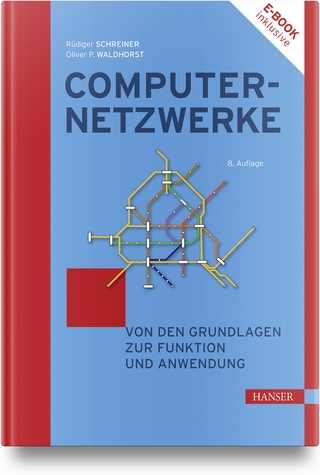
Wireless Sensor Networks
Wiley-IEEE Press (Verlag)
978-0-470-16763-2 (ISBN)
- Lieferbar (Termin unbekannt)
- Versandkostenfrei innerhalb Deutschlands
- Auch auf Rechnung
- Verfügbarkeit in der Filiale vor Ort prüfen
- Artikel merken
Learn the fundamental concepts, major challenges, and effective solutions in wireless sensor networking This book provides a comprehensive and systematic introduction to the fundamental concepts, major challenges, and effective solutions in wireless sensor networking (WSN). Distinguished from other books, it focuses on the networking aspects of WSNs and covers the most important networking issues, including network architecture design, medium access control, routing and data dissemination, node clustering, node localization, query processing, data aggregation, transport and quality of service, time synchronization, network security, and sensor network standards.
With contributions from internationally renowned researchers, Wireless Sensor Networks expertly strikes a balance between fundamental concepts and state-of-the-art technologies, providing readers with unprecedented insights into WSNs from a networking perspective. It is essential reading for a broad audience, including academic researchers, research engineers, and practitioners in industry. It is also suitable as a textbook or supplementary reading for electrical engineering, computer engineering, and computer science courses at the graduate level.
Jun Zheng, PhD, is a Professor with the School of Information Science and Engineering of the Southeast University, China. He has been involved in extensive research and development in the field of telecommunications engineering for many years. He is a technical editor of IEEE Communications Magazine and the online magazine IEEE Communications Surveys & Tutorials. He has coauthored one book and has published a number of technical papers in refereed journals, magazines, and conference proceedings. An award-winning scientist in the communications technology field, Dr. Zheng is a senior member of the IEEE. Abbas Jamalipour, PhD, is a Professor of Wireless Networking at the University of Sydney, Australia, where he is responsible for teaching and research in wireless data communication networks, wireless IP networks, network security, and cellular communications. He is the Editor in Chief of the IEEE Wireless Communications and technical editor of IEEE Communications Magazine and the International Journal of Communication Science. Dr. Jamalipour has authored or coauthored a dozen books and has published more than 190 papers in major journals and international conferences. He is a Fellow of the IEEE and Engineers Australia, as well as an IEEE Distinguished Lecturer.
Preface xxiii
Acknowledgments xxv
About the Editors xxvii
Contributors xxix
1. Introduction to Wireless Sensor Networks 1
Jun Zheng and Abbas Jamalipour
1.1 Overview of Wireless Sensor Networks 1
1.1.1 Network Characteristics 2
1.1.2 Network Applications 3
1.1.3 Network Design Objectives 6
1.1.4 Network Design Challenges 7
1.2 Technological Background 8
1.2.1 MEMS Technology 9
1.2.2 Wireless Communication Technology 9
1.2.3 Hardware and Software Platforms 10
1.2.4 Wireless Sensor Network Standards 12
1.3 Features of This Book 15
1.4 Organization of This Book 15
References 16
2. Network Architectures and Protocol Stack 19
Jun Zheng
2.1 Introduction 19
2.2 Network Architectures for Wireless Sensor Networks 20
2.2.1 Sensor Node Structure 20
2.2.2 Network Architectures 21
2.3 Classifications of Wireless Sensor Networks 24
2.4 Protocol Stack for Wireless Sensor Networks 26
2.4.1 Application Layer 28
2.4.2 Transport Layer 28
2.4.3 Network Layer 29
2.4.4 Data Link Layer 29
2.4.5 Physical Layer 30
2.5 Summary 31
References 31
3. Medium Access Control 35
Jun Zheng
3.1 Introduction 35
3.2 Fundamental MAC Protocols 36
3.2.1 Contention-Based MAC Protocols 36
3.2.2 Contention-Free MAC Protocols 38
3.3 MAC Design for Wireless Sensor Networks 39
3.3.1 Network Characteristics 39
3.3.2 Objectives of MAC Design 40
3.3.3 Energy Efficiency in MAC Design 41
3.4 MAC Protocols for Wireless Sensor Networks 42
3.4.1 Contention-Based Protocols 42
3.4.2 Contention-Free Protocols 53
3.4.3 Hybrid Protocols 58
3.5 Summary and Future Directions 61
References 62
4. Routing and Data Dissemination 67
Sajal K. Das and Habib M. Ammari
4.1 Introduction 67
4.2 Fundamentals and Challenges 68
4.2.1 Fundamentals 68
4.2.2 Challenges 71
4.3 Taxonomy of Routing and Data Dissemination Protocols 73
4.3.1 Location Information 74
4.3.2 Network Layering and In-Network Processing 74
4.3.3 Data Centricity 75
4.3.4 Path Redundancy 75
4.3.5 Network Dynamics 76
4.3.6 Quality of Service Requirements 76
4.3.7 Network Heterogeneity 77
4.4 Overview of Routing and Data Dissemination Protocols 77
4.4.1 Location-Aided Protocols 78
4.4.2 Layered and In-Network Processing-Based Protocols 87
4.4.3 Data-Centric Protocols 93
4.4.4 Multipath-Based Protocols 109
4.4.5 Mobility-Based Protocols 113
4.4.6 QoS Based Protocols 123
4.4.7 Heterogeneity-Based Protocols 129
4.4.8 Comparisons 136
4.5 Summary and Future Directions 137
References 139
5. Broadcasting, Multicasting, and Geocasting 145
Baoxian Zhang and Guoliang Xue
5.1 Introduction 145
5.2 Concepts and Major Challenges 146
5.2.1 Basic Concepts 146
5.2.2 Design Guidelines and Challenges 147
5.3 Broadcasting Mechanisms 149
5.3.1 Simple Broadcasting Mechanisms 149
5.3.2 Neighborhood-Aware Broadcasting Mechanisms 150
5.3.3 Location-Aided Broadcasting Mechanisms 153
5.3.4 Energy-Efficient Broadcasting Mechanisms 156
5.3.5 Reliable Broadcasting Mechanisms 158
5.4 Multicasting Mechanisms 160
5.4.1 Tree-Based Multicasting Mechanisms 161
5.4.2 Location-Based Multicasting Mechanisms 162
5.5 Geocasting Mechanisms 164
5.5.1 Nonguaranteed Geocasting Mechanisms 164
5.5.2 Guaranteed Geocasting Mechanisms 166
5.6 Summary and Future Directions 167
Acknowledgments 168
References 169
6. Node Clustering 173
Chao Zhang, Edwin Hou, and Nirwan Ansari
6.1 Introduction 173
6.1.1 Wireless Sensor Network Architectures 174
6.1.2 Node Clustering Structures 178
6.2 Node Clustering Algorithms 180
6.2.1 Cluster-Head Election Algorithms 181
6.2.2 Node Clustering Algorithms in Ad Hoc Networks 183
6.3 Node Clustering Algorithms for Wireless Sensor Networks 188
6.3.1 Specialties for Clustering in Wireless Sensor Networks 188
6.3.2 Passive Clustering for Efficient Flooding 189
6.3.3 Energy-Efficient Adaptive Clustering 193
6.3.4 Energy-Efficient Distributed Clustering 195
6.3.5 Energy-Efficient Hierarchical Clustering 196
6.3.6 Algorithm for Cluster Establishment 201
6.3.7 Secure Clustering 203
6.4 Summary and Future Directions 208
References 209
7. Query Processing and Data Aggregation 215
Torsha Banerjee and Dharma P. Agrawal
7.1 Introduction 215
7.2 Query Processing in Wireless Sensor Networks 217
7.2.1 Query Characteristics 217
7.2.2 Challenges in Query Processing 220
7.2.3 Sensor Selection for Query Processing 221
7.2.4 Query Processing Techniques 222
7.2.5 Snapshot Querying 225
7.3 Data Aggregation in Wireless Sensor Networks 229
7.3.1 Challenges in Data Aggregation 229
7.3.2 Data Aggregation Techniques 230
7.4 Summary and Future Directions 239
References 240
8. Node Localization 243
Nayef A. Alsindi and Kaveh Pahlavan
8.1 Introduction 243
8.2 Concepts and Challenges of Node Localization Technologies 244
8.2.1 Evolution of Localization Technologies 244
8.2.2 Localization Systems 245
8.2.3 Challenges of Node Localization in Wireless Sensor Networks 247
8.3 Ranging Techniques for Wireless Sensor Networks 248
8.3.1 TOA Based Ranging 249
8.3.2 RSS Based Ranging 254
8.4 Wireless Localization Algorithms 257
8.4.1 Background 258
8.4.2 Geometrical Triangulation Techniques 258
8.4.3 Pattern Recognition Techniques 262
8.5 Wireless Sensor Node Localization 262
8.5.1 Cooperative Localization 263
8.5.2 Centralized Localization Algorithms 267
8.5.3 Distributed Localization Algorithms 269
8.6 Summary and Future Directions 279
References 280
9. Time Synchronization 285
Fikret Sivrikaya and Bülent Yener
9.1 Introduction 285
9.1.1 Computer Clocks and the Synchronization Problem 286
9.1.2 Common Challenges for Synchronization Methods 287
9.2 Need for Synchronization in Wireless Sensor Networks 288
9.3 Requirements of Synchronization in Wireless Sensor Networks 289
9.4 Synchronization Protocols for Wireless Sensor Networks 290
9.4.1 Synchronization Primitives 290
9.4.2 Multihop Synchronization 295
9.4.3 Long-Term Synchronization 299
9.4.4 Other Protocols and Relevant Work 302
9.5 Summary and Future Directions 303
References 305
10. Energy Efficiency and Power Control 307
Nikolaos A. Pantazis and Dimitrios D. Vergados
10.1 Introduction 307
10.2 Need for Energy Efficiency and Power Control in Wireless Sensor Networks 308
10.2.1 Power Consumption in Sensor Nodes 308
10.2.2 Power Control at Different Protocol Layers 311
10.2.3 Classification of Power Conservation Mechanisms for Wireless Sensor Networks 313
10.3 Passive Power Conservation Mechanisms 314
10.3.1 Physical-Layer Power Conservation Mechanisms 314
10.3.2 MAC Layer Power Conservation Mechanisms 318
10.3.3 Higher Layer Power Conservation Mechanisms 320
10.4 Active Power Conservation Mechanisms 327
10.4.1 MAC Layer Mechanisms 327
10.4.2 Network Layer Mechanisms 331
10.4.3 Transport Layer Mechanisms 335
10.5 Summary 337
References 337
11. Transport Protocols and Quality of Service 343
Chonggang Wang, Bo Li, and Kazem Sohraby
11.1 Introduction 343
11.2 Traditional Transport Protocols 346
11.2.1 Principles of Traditional Transport Protocols 346
11.2.2 Disadvantages of TCP and UDP 347
11.3 Transport Protocol Design for Wireless Sensor Networks 349
11.3.1 Performance Metrics 349
11.3.2 Congestion Control 351
11.3.3 Loss Recovery 353
11.3.4 Design Guidelines 355
11.4 Transport Protocols for Wireless Sensor Networks 356
11.4.1 Protocols for Congestion Control 356
11.4.2 Protocols for Reliability 360
11.4.3 Protocols for Congestion Control and Reliability 363
11.4.4 Open Problems 365
11.5 Summary and Future Directions 366
References 366
12. Network Security and Attack Defense 369
Yun Zhou and Yuguang Fang
12.1 Introduction 369
12.2 Confidentiality 370
12.2.1 Eavesdropping 371
12.2.2 Node Compromise 371
12.2.3 Encryption 372
12.2.4 Privacy 373
12.3 Integrity 374
12.3.1 Transmission Errors 374
12.3.2 Processing Errors 375
12.3.3 Packet Modifications 375
12.3.4 Error Control 375
12.3.5 Message Integrity Code 376
12.4 Authenticity 376
12.4.1 Packet Injection 376
12.4.2 Message Authentication Code 376
12.4.3 Challenge Response 377
12.4.4 Signature 377
12.4.5 Man-in-the-Middle 377
12.4.6 Authenticating Public Key 378
12.4.7 Broadcast and Multicast Authentication 380
12.5 Nonrepudiation 384
12.6 Freshness 385
12.6.1 Packet Replaying 385
12.6.2 Timestamp 386
12.7 Availability 386
12.7.1 Selective Forwarding 387
12.7.2 Radio Jamming 387
12.7.3 Multipath Routing 387
12.7.4 False Reports 388
12.7.5 Node Replication 389
12.8 Intrusion Detection 390
12.9 Key Management 391
12.9.1 Symmetric Key Management 391
12.9.2 Asymmetric Key Management 398
12.9.3 Group Key Management 399
12.10 Summary 400
Acknowledgments 400
References 400
13. Sensor Network Standards 407
Stefano Chessa
13.1 Introduction 407
13.2 IEEE 802.15.4 Standard 408
13.2.1 Overview of the MAC Layer 409
13.2.2 Channel Access 410
13.2.3 Data-Transfer Models 411
13.2.4 MAC Layer Services 414
13.2.5 Security 417
13.3 ZigBee Standard 418
13.3.1 Network Layer 418
13.3.2 Application Layer 426
13.3.3 Security in ZigBee 430
13.4 Summary 430
References 431
14. Future Trends in Wireless Sensor Networks 433
Mehmet Can Vuran, Dario Pompili, and Tommaso Melodia
14.1 Introduction 433
14.2 Wireless Multimedia Sensor Networks 434
14.2.1 Applications of Wireless Multimedia Sensor Networks 436
14.2.2 Design of Wireless Multimedia Sensor Networks 437
14.2.3 Ultra-Wideband Technology 439
14.2.4 Cross-Layer Design 441
14.3 Wireless Sensor and Actor Networks 443
14.3.1 Applications of Wireless Sensor and Actor Networks 444
14.3.2 Sensor and Actor Coordination 445
14.4 Sensor Network Applications in Challenging Environments 448
14.4.1 Underwater Acoustic Sensor Networks 448
14.4.2 Wireless Underground Sensor Networks 453
14.5 Cross-Layer Design for Wireless Sensor Networks 456
14.5.1 Cross-Layer Resource Allocation 457
14.5.2 Pairwise Cross-Layer Protocols 460
14.5.3 Cross-Layer Module Design 463
14.5.4 Precautionary Guidelines and Open Research Problems 464
14.6 Summary 466
Acknowledgments 466
References 466
Index 471
| Erscheint lt. Verlag | 16.10.2009 |
|---|---|
| Zusatzinfo | Charts: 45 B&W, 0 Color; Drawings: 5 B&W, 0 Color; Tables: 15 B&W, 0 Color; Graphs: 30 B&W, 0 Color |
| Sprache | englisch |
| Maße | 161 x 243 mm |
| Gewicht | 821 g |
| Themenwelt | Mathematik / Informatik ► Informatik ► Netzwerke |
| Technik ► Elektrotechnik / Energietechnik | |
| ISBN-10 | 0-470-16763-7 / 0470167637 |
| ISBN-13 | 978-0-470-16763-2 / 9780470167632 |
| Zustand | Neuware |
| Haben Sie eine Frage zum Produkt? |
aus dem Bereich


